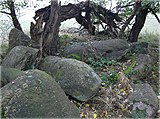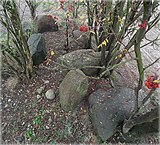Large stone graves near Schadewohl
| Large stone graves near Schadewohl | |||
|---|---|---|---|
|
Great stone grave at Schadewohl 1 |
|||
|
|||
| Coordinates | Schadewohl 1 , Schadewohl 2 , Schadewohl 3 | ||
| place | Diesdorf , Saxony-Anhalt , Germany | ||
| Emergence | 3700 to 3350 BC Chr. | ||
The megalithic graves near Schadewohl were originally five or six megalithic tombs of the Neolithic deep-engraving ceramic culture near Schadewohl , a district of the community of Diesdorf in the Altmarkkreis Salzwedel , Saxony-Anhalt . Today only three graves remain, two more were destroyed in the 19th century. The field name "Steinberge" indicates at least one other destroyed grave.
location
The three graves are located about 1.5 km southwest of the center of Schadewohl in a field. Grave 1 is the westernmost facility, grave 2 is 400 m east-southeast of it and grave 3 is another 320 m south-east. The destroyed grave 4 was on the border to Diesdorf and grave 5 200 m east of grave 4. There are several other large stone graves in the vicinity: 1.1 km south-east, the large stone graves adjoin Diesdorf , 2.7 km south-east the large stone grave Whey .
Research history
The graves were first described in 1843 by Johann Friedrich Danneil . At the beginning of the 1890s, Eduard Krause and Otto Schoetensack discovered that only three graves were left when the Altmark stone graves were taken again. The remaining facilities had been destroyed in the meantime. In 2003-04, all remaining large stone graves in the Altmark were recorded and measured as a joint project of the State Office for Monument Preservation and Archeology of Saxony-Anhalt , the Johann Friedrich Danneil Museum in Salzwedel and the association “Young Archaeologists of the Altmark”.
description
Preserved graves
Grave 1
Grave 1 belongs to the large dolmen type . A pile of hills cannot be made out, and there is no longer a grave border today. The burial chamber is oriented northwest-southeast. Today it still consists of ten wall stones and four cap stones, further stones are now missing. The largest capstone measures 2.7 m × 0.8 m × 0.7 m. The westernmost capstone has a deep groove. The next capstone has three bowls . The wall stones are partially broken. The chamber is trapezoidal, has a length of 8.0 m and a width between 1.4 m and 2.0 m.
Grave 2
Grave 2 also belongs to the large dolmen type that is not very common here. Even with this system, no mound can be seen. A burial mound border is also missing, it may never have been there. The burial chamber is oriented northwest-southeast. Today it still consists of nine bearing stones and two cap stones. The original dimensions of the capstones were 3.2 m × 1.6 m or 2.5 m × 1.4 m. However, the western stone has already broken into three parts and the eastern stone has a deep gap. Both cap stones have bowls . The chamber is rectangular and has internal dimensions 5.7 m × 1.5 m, its height is 1.2 m.
Grave 3
Grave 3 also belongs to the large dolmen type. The mound is oval, there is no grave border. The burial chamber is oriented northwest-southeast. It originally consisted of probably eight wall stones, seven of which have survived, and three or four cap stones, two of which have survived. One of the capstones is supported in the chamber, the other is outside. The two stones measure 2.4 m × at least 1.0 m × 0.8 m and 2.5 m × 1.2 m, respectively. The chamber is rectangular and has internal dimensions 4.7 mx 2.0 m.
Destroyed graves
Grave 4
Grave 4 was 8.8 m long and 4.7 m wide. It was oriented west-east and had a burial chamber with three cap stones; it must have been a large dolmen or a passage grave. It was still well preserved when Johann Friedrich Danneil examined it in the 1830s, but was completely removed in the 1850s.
Grave 5
Grave 5 had a burial chamber that was 4 m long and almost as wide. It had a single large capstone. No information is available about the number of wall stones, but the size of the chamber makes it probable that it was a polygonal pole . This grave form is rare in the Altmark and is otherwise only attested by two destroyed large stone graves near Wallstawe and the preserved large stone grave Lüdelsen 1 .
The megalithic graves near Schadewohl in regional legends
A regional legend tells of giants who had seven toes on their feet. The bowls on the stones of the Schadewohler large stone graves are said to be the prints of such giant toes.
See also
literature
- Hans-Jürgen Beier : The megalithic, submegalithic and pseudomegalithic buildings as well as the menhirs between the Baltic Sea and the Thuringian Forest. Contributions to the prehistory and early history of Central Europe 1. Wilkau-Haßlau 1991, p. 58.
- J. Beranek: Salzwedeler Heimathefte. Issue 1, 1957, p. 3.
- J. Beranek: Salzwedeler Heimathefte. Volume 6, 1957, p. 2.
- Wilhelm Blasius : Guide to the megalithic grave monuments in the western part of the Salzwedel district. In: Thirty-first annual report of the Altmark Association for Patriotic History and Industry. Issue 2, 1904, p. 100 ( PDF; 8.1 MB ).
- Hartmut Bock , Barbara Fritsch, Lothar Mittag: Great stone graves of the Altmark . State Office for Monument Preservation and Archeology Saxony-Anhalt and State Museum for Prehistory, Halle (Saale) 2006, ISBN 3-939414-03-4 , pp. 141–147.
- Johann Friedrich Danneil : Special evidence of the barrows in the Altmark . In: Sixth annual report of the Altmark Association for Patriotic History and Industry . 1843, p. 100 ( PDF; 5.5 MB ).
- Hans-Ulrich Kelch: Mysterious pans. In: Hartmut Bock (Ed.): Cities - Villages - Friedhöfe. Archeology in the Altmark 2: From the High Middle Ages to the modern age (= contributions to the cultural history of the Altmark and its peripheral areas, Volume 8). Oschersleben 2002, ISBN 3-935358-36-9 , pp. 458-469.
- Eduard Krause , Otto Schoetensack : The megalithic graves (stone chamber graves) of Germany . I .: Altmark . In: Journal of Ethnology . Vol. 25, 1893, pp. 143-144 / no. 57–59, Plates VI / 57–59, VII / 57–59, IX / 57 ( PDF; 39.0 MB ).
- Britta Schulze-Thulin : Large stone graves and menhirs. Saxony-Anhalt • Thuringia • Saxony . Mitteldeutscher Verlag, Halle (Saale) 2007, ISBN 978-3-89812-428-7 , p. 41.
Web links
- The Megalithic Portal: Grave 1 , Grave 2 , Grave 3
- KLEKs Online: Grave 1 , Grave 2 , Grave 3
- grosssteingraeber.de: grave 1 , grave 2 , grave 3
- strahlen.org: grave 1 , grave 2 , grave 3
Individual evidence
- ↑ Hartmut Bock, Barbara Fritsch, Lothar Mittag: Großsteingraves der Altmark. 2006, p. 11.
- ↑ Hartmut Bock, Barbara Fritsch, Lothar Mittag: Großsteingraves der Altmark. 2006, p. 141
- ↑ Hartmut Bock, Barbara Fritsch, Lothar Mittag: Großsteingraves der Altmark. 2006, p. 143
- ↑ Hartmut Bock, Barbara Fritsch, Lothar Mittag: Großsteingraves der Altmark. 2006, p. 146
- ↑ Hartmut Bock, Barbara Fritsch, Lothar Mittag: Großsteingraves der Altmark. 2006, p. 144















